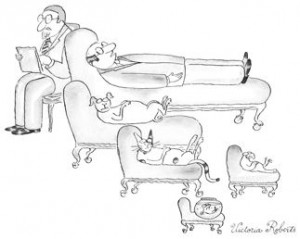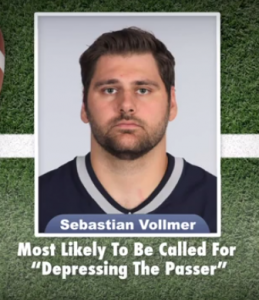Say you want to write a funny caption for this cartoon, which was the subject of Caption Contest #447 in The New Yorker.
You write funny captions for uncaptioned cartoons the same way you’d write jokes about a Found Photo, which is an unaltered photo that wasn’t originally intended to be funny. Examples of Found Photos are the animal photos on the website I Can Has Cheezburger?…
…and the athletes’ headshots in the comedy piece “Superlatives” on The Tonight Show Starring Jimmy Fallon.
Follow these steps to write a funny caption for a cartoon, photo, or other picture:
A) Briefly describe the scene in the picture using its handles. The handles are the one or two most distinctive people or things in the picture and the action that those people or things are performing. This descriptive sentence will bridge the visual picture and a verbal punch line, i.e., the funny caption.
In the case of the New Yorker contest cartoon, the descriptive sentence would be something like, “A guy’s pets have psychotherapy.”
B) Use that descriptive sentence and the Punch Line Makers to create a funny caption. The Punch Line Makers are the six proven techniques for creating punch lines that I cover in my book Comedy Writing for Late-Night TV.
In the case of the New Yorker contest cartoon, the winning writer, Alonso Cisneros, apparently used Punch Line Maker #1: Link two associations of the topic. Here’s how he went about it.
The topic—the descriptive sentence—is “A guy’s pets have psychotherapy.”
 Brainstorming on the handle “pets” produces associations like “hair on the furniture,” “shelter animal,” “adoption,” “cat food,” “veterinarian,” “do tricks,” and “leash laws.”
Brainstorming on the handle “pets” produces associations like “hair on the furniture,” “shelter animal,” “adoption,” “cat food,” “veterinarian,” “do tricks,” and “leash laws.”
Brainstorming on the handle “psychotherapy” yields associations like “depression,” “fifty-minute hour,” “my parents hate me,” “childhood trauma,” “I was adopted,” “couch,” and “Freud.”
At least one association, the one involving adoption, appears in similar form on both lists. Linking those two associations results in the winning caption:
“My pets found out they were adopted.”
C) Edit the caption using the Joke Maximizers. The Joke Maximizers are twelve tools for editing jokes to make them as funny as possible; I list them in my book. The writer of the winning caption used these Punch Line Makers:
Punch Line Maker #1: Shorten as much as possible. The caption doesn’t have any unnecessary words or syllables.
Punch Line Maker #2: End on the laugh trigger. The most surprising word in the caption—“adopted”—is at the very end.
Punch Line Maker #4: Make everything clear. Every word in the caption is simple. Not only that, the words “my pets” make it clear that the man on the couch is talking. That’s important because it’s not immediately clear from the drawing itself which human or animal is talking, if any.


